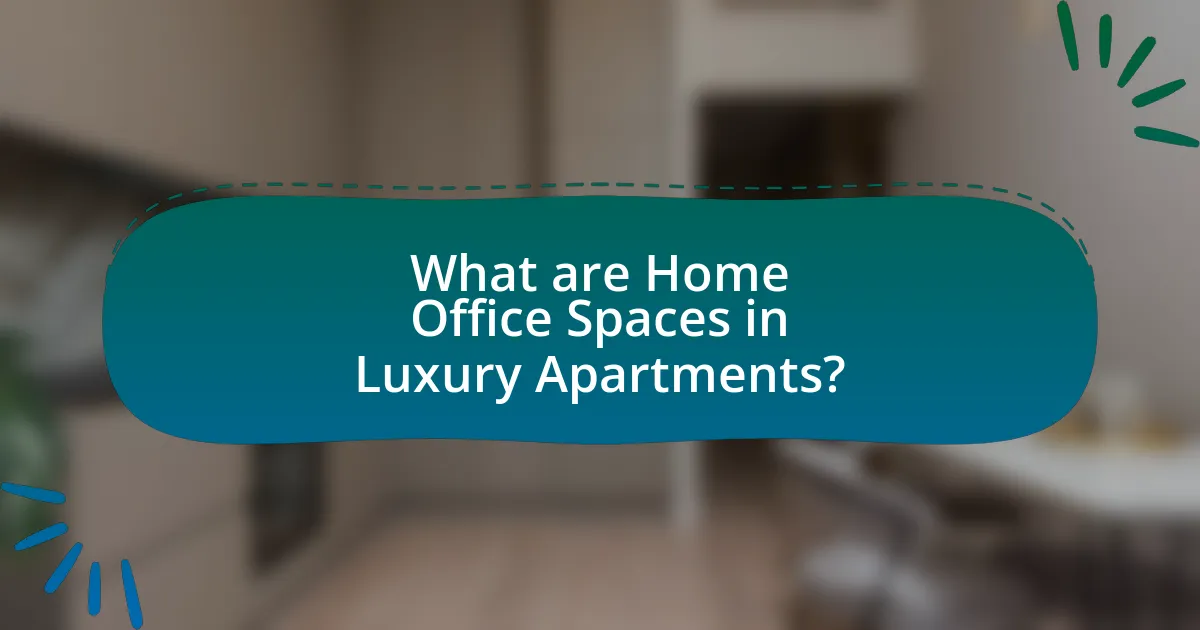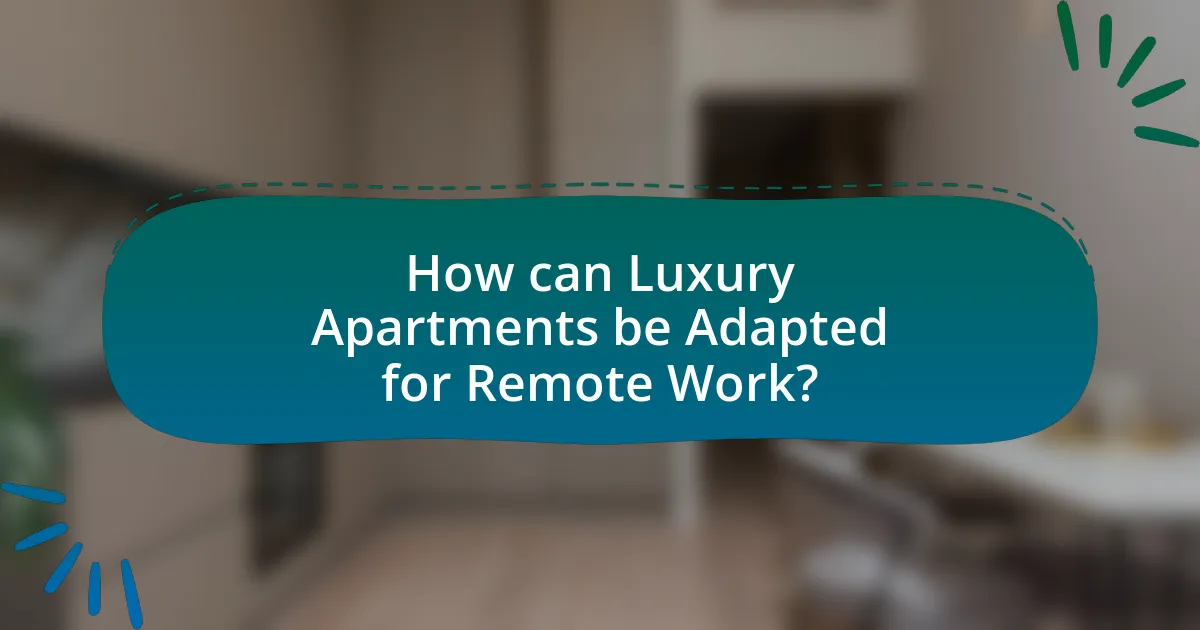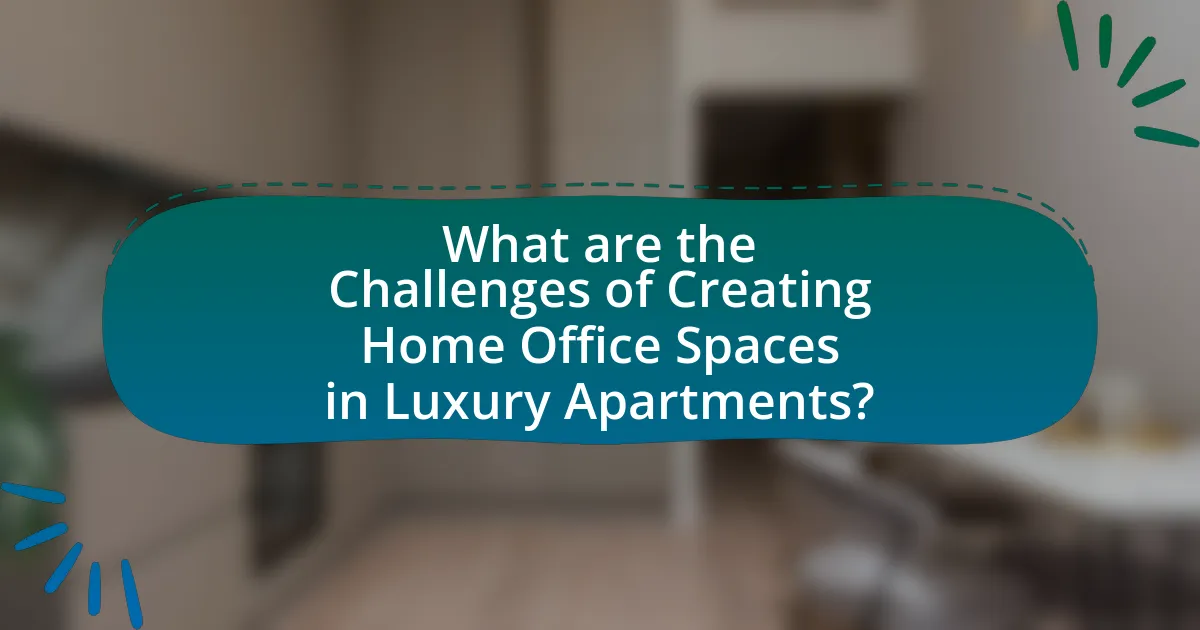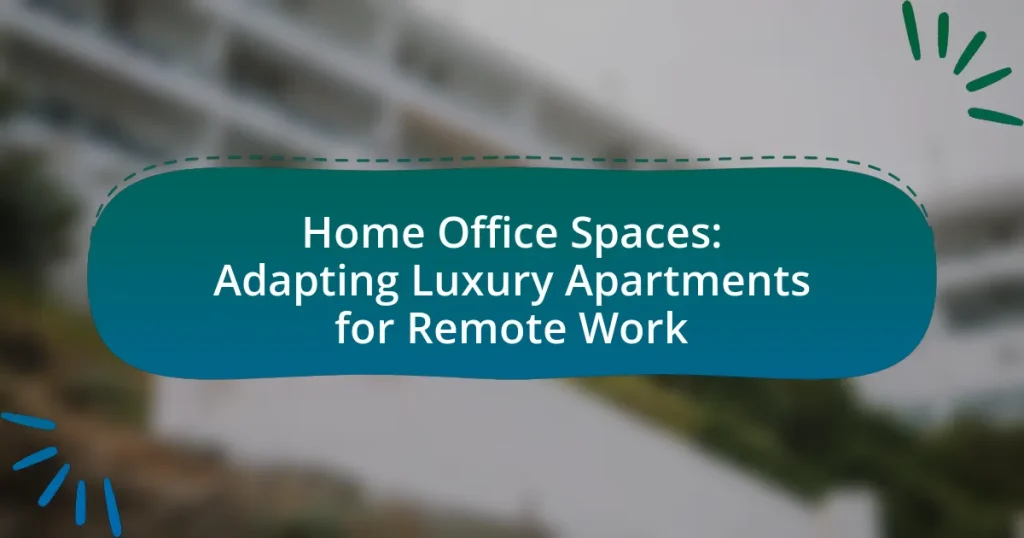Home office spaces in luxury apartments are specialized areas designed to facilitate remote work, featuring high-end finishes, ergonomic furniture, and advanced technology. These spaces differ from traditional office setups by prioritizing comfort and personalization, allowing for flexible layouts that reflect individual styles. The article explores the unique features of luxury home offices, the increasing demand for such spaces due to the rise of remote work, and the design strategies that enhance functionality while maintaining aesthetic appeal. Additionally, it addresses the challenges residents face when adapting their apartments for remote work and offers practical tips for creating an effective home office environment.

What are Home Office Spaces in Luxury Apartments?
Home office spaces in luxury apartments are dedicated areas designed for remote work, often featuring high-end finishes and ergonomic furniture. These spaces are typically equipped with advanced technology, ample natural light, and soundproofing to enhance productivity and comfort. The integration of home office spaces in luxury apartments reflects the growing trend of remote work, catering to professionals who require a functional yet aesthetically pleasing environment.
How do Home Office Spaces differ from traditional office setups?
Home office spaces differ from traditional office setups primarily in their design and functionality, catering to individual needs and preferences. Home offices typically prioritize comfort and personalization, allowing for flexible layouts and decor that reflect the occupant’s style, while traditional offices often adhere to standardized designs aimed at maximizing space efficiency and collaboration among employees. Additionally, home office spaces often incorporate technology that supports remote work, such as high-speed internet and ergonomic furniture, which may not be as prevalent in traditional office environments. This shift towards personalized workspaces has been accelerated by the rise of remote work, with studies indicating that 70% of employees prefer a hybrid work model that includes home office setups.
What features make a home office in a luxury apartment unique?
A home office in a luxury apartment is unique due to its high-end design, advanced technology, and premium materials. These offices often feature custom cabinetry, ergonomic furniture, and soundproofing to enhance productivity and comfort. Additionally, luxury home offices may include large windows with stunning views, allowing for natural light and an inspiring environment. The integration of smart home technology, such as automated lighting and climate control, further distinguishes these spaces, providing convenience and efficiency. High-quality finishes, such as marble or hardwood flooring, and bespoke artwork contribute to an upscale aesthetic, making the home office not just functional but also a statement of luxury living.
How does the design of luxury apartments enhance home office functionality?
The design of luxury apartments enhances home office functionality by incorporating dedicated workspaces, high-quality materials, and advanced technology. These apartments often feature separate rooms or alcoves specifically designed for office use, allowing for a distraction-free environment that promotes productivity. Additionally, luxury apartments typically include soundproofing and ergonomic furniture, which contribute to comfort and focus during work hours. High-speed internet and integrated smart home systems further facilitate efficient remote work, ensuring that residents have access to the tools they need for seamless communication and task management.
Why is the demand for Home Office Spaces increasing?
The demand for home office spaces is increasing primarily due to the rise in remote work and flexible working arrangements. According to a survey by Stanford University, 42% of the U.S. labor force was working remotely full-time as of 2020, a significant increase from pre-pandemic levels. This shift has led individuals to seek dedicated spaces within their homes that enhance productivity and provide a professional environment. Additionally, the trend towards hybrid work models, where employees split their time between home and the office, further drives the need for functional home office setups.
What trends are driving the shift towards remote work in luxury living?
The trends driving the shift towards remote work in luxury living include the increasing demand for flexible work arrangements, advancements in technology, and a focus on wellness and lifestyle. Flexible work arrangements have become essential as employees seek a better work-life balance, leading luxury living spaces to adapt by incorporating dedicated home office areas. Advancements in technology, such as high-speed internet and smart home features, enable seamless remote work experiences, making luxury apartments more appealing. Additionally, a growing emphasis on wellness has prompted developers to create environments that promote productivity and comfort, integrating features like natural light, ergonomic furniture, and quiet spaces conducive to work. These trends collectively reflect a significant transformation in how luxury living spaces are designed to accommodate the needs of remote workers.
How has the pandemic influenced the need for home office spaces?
The pandemic has significantly increased the need for home office spaces as remote work became a necessity for many employees. According to a survey by Stanford University, 42% of the U.S. workforce was working from home full-time during the pandemic, highlighting a shift in work culture. This shift has led to a demand for dedicated workspaces within homes, prompting individuals to adapt their living environments to accommodate professional needs. As a result, luxury apartments are increasingly being designed or modified to include functional office areas, reflecting the long-term changes in work habits and preferences.

How can Luxury Apartments be Adapted for Remote Work?
Luxury apartments can be adapted for remote work by incorporating dedicated office spaces, ergonomic furniture, and high-speed internet connectivity. Creating a designated workspace within the apartment allows for better focus and productivity, while ergonomic furniture, such as adjustable desks and supportive chairs, enhances comfort during long working hours. Additionally, ensuring high-speed internet access is crucial, as it supports seamless video conferencing and efficient online collaboration. These adaptations not only improve work efficiency but also contribute to a healthier work-life balance in a luxury living environment.
What are the key considerations when designing a home office in a luxury apartment?
Key considerations when designing a home office in a luxury apartment include space optimization, aesthetic integration, and technology infrastructure. Space optimization ensures that the office is functional without compromising the apartment’s overall layout, often requiring custom furniture solutions that maximize utility while maintaining elegance. Aesthetic integration involves selecting decor and furnishings that complement the luxury apartment’s style, ensuring the office feels cohesive with the living space. Technology infrastructure is critical, necessitating high-speed internet access, adequate power outlets, and ergonomic equipment to support productivity. These considerations are essential for creating a sophisticated and efficient work environment that aligns with the luxury lifestyle.
How can space optimization improve productivity in home offices?
Space optimization can significantly improve productivity in home offices by creating a more organized and efficient work environment. When space is utilized effectively, it minimizes distractions and enhances focus, allowing individuals to concentrate better on their tasks. Research indicates that a well-organized workspace can lead to a 20-30% increase in productivity, as employees spend less time searching for materials and more time on productive activities. Additionally, optimizing space can facilitate better ergonomics, reducing physical strain and fatigue, which further contributes to sustained productivity levels.
What role does lighting play in creating an effective home office environment?
Lighting plays a crucial role in creating an effective home office environment by enhancing focus, reducing eye strain, and improving overall mood. Proper lighting, including a combination of natural and artificial sources, helps to create a workspace that promotes productivity and comfort. Studies indicate that exposure to natural light can increase alertness and concentration, while well-placed artificial lighting can minimize shadows and glare, which are common distractions. For instance, a report from the American Society of Interior Designers highlights that well-lit environments can lead to a 20% increase in productivity. Therefore, effective lighting design is essential for optimizing the functionality and ambiance of a home office.
What are the best practices for integrating technology into home office spaces?
The best practices for integrating technology into home office spaces include ensuring reliable internet connectivity, utilizing ergonomic furniture with built-in tech features, and implementing smart home devices for enhanced productivity. Reliable internet connectivity is crucial, as studies show that 90% of remote workers consider a stable internet connection essential for their productivity. Ergonomic furniture, such as adjustable desks and chairs with integrated USB ports, promotes comfort and efficiency, reducing the risk of strain during long working hours. Additionally, smart home devices like voice-activated assistants and automated lighting systems can streamline tasks and create a conducive work environment, ultimately improving overall work performance.
How can smart home technology enhance the remote work experience?
Smart home technology can enhance the remote work experience by automating tasks and improving the work environment. For instance, smart lighting systems can adjust brightness based on the time of day, reducing eye strain and increasing productivity. Additionally, smart thermostats can maintain optimal temperature settings, ensuring comfort during long work hours. A study by the National Institute of Health found that a comfortable work environment can boost productivity by up to 25%. Furthermore, smart speakers and virtual assistants can streamline workflows by managing schedules and reminders, allowing for more efficient time management. These technologies collectively create a more conducive atmosphere for remote work, ultimately leading to better performance and job satisfaction.
What essential tech tools should be included in a luxury home office?
A luxury home office should include high-quality tech tools such as a powerful computer, ergonomic chair, adjustable standing desk, high-resolution monitor, and advanced video conferencing equipment. These tools enhance productivity and comfort, essential for remote work. For instance, a powerful computer with a fast processor and ample RAM ensures smooth multitasking, while a high-resolution monitor improves visual clarity for design or data-intensive tasks. Ergonomic furniture, like an adjustable standing desk and supportive chair, promotes health and well-being during long working hours. Additionally, advanced video conferencing equipment, such as a high-definition webcam and quality microphone, facilitates clear communication in virtual meetings, which is crucial for professional interactions.

What are the Challenges of Creating Home Office Spaces in Luxury Apartments?
Creating home office spaces in luxury apartments presents challenges such as limited space, noise distractions, and the need for aesthetic integration. Limited space can restrict the functionality and layout of a home office, making it difficult to accommodate necessary equipment and furniture. Noise distractions from urban environments can hinder productivity, especially in high-density areas where luxury apartments are often located. Additionally, integrating a home office into the existing luxury design requires careful consideration to maintain the apartment’s overall aesthetic appeal, which can complicate the design process. These factors collectively impact the effectiveness and comfort of a home office in a luxury setting.
What common obstacles do residents face when adapting their apartments for remote work?
Residents commonly face space constraints, inadequate lighting, and noise disturbances when adapting their apartments for remote work. Limited square footage often restricts the creation of a dedicated workspace, leading to distractions and decreased productivity. Insufficient natural light can negatively impact mood and focus, while external noise from neighbors or street traffic can disrupt concentration. According to a survey by the American Psychological Association, 60% of remote workers reported that noise was a significant barrier to their productivity at home.
How can noise and distractions be minimized in a home office setting?
To minimize noise and distractions in a home office setting, individuals should implement soundproofing techniques and establish a dedicated workspace. Soundproofing can include using acoustic panels, heavy curtains, or rugs to absorb sound, which has been shown to reduce noise levels significantly. Creating a dedicated workspace helps to mentally separate work from personal life, thereby enhancing focus and productivity. Research indicates that a well-defined workspace can lead to a 20-30% increase in productivity, as it reduces the likelihood of distractions from other household activities.
What solutions exist for limited space in luxury apartments?
Solutions for limited space in luxury apartments include multifunctional furniture, vertical storage, and open floor plans. Multifunctional furniture, such as sofa beds and extendable dining tables, maximizes utility without sacrificing style. Vertical storage solutions, like wall-mounted shelves and cabinets, utilize vertical space effectively, allowing for more floor area. Open floor plans enhance the sense of space by minimizing walls and barriers, creating a more fluid living environment. These strategies are supported by design principles that emphasize efficiency and aesthetics, making them ideal for luxury living while accommodating remote work needs.
How can residents overcome these challenges effectively?
Residents can effectively overcome challenges related to adapting luxury apartments for remote work by optimizing their home office spaces. This can be achieved through strategic organization, such as designating a specific area for work that minimizes distractions and enhances productivity. Research indicates that having a dedicated workspace can significantly improve focus and efficiency, with studies showing that individuals who work in a defined area are 20% more productive than those who do not. Additionally, investing in ergonomic furniture and proper lighting can further enhance comfort and reduce physical strain, contributing to a more effective remote work environment.
What design strategies can help create a focused work environment?
Design strategies that can help create a focused work environment include optimizing layout, utilizing soundproofing materials, and incorporating natural light. An optimized layout, such as an open floor plan with designated work zones, minimizes distractions and enhances productivity. Soundproofing materials, like acoustic panels, reduce noise pollution, allowing for better concentration. Additionally, incorporating natural light through large windows or skylights has been shown to improve mood and focus, as studies indicate that exposure to natural light can enhance cognitive function and overall well-being.
How can residents balance aesthetics and functionality in their home office?
Residents can balance aesthetics and functionality in their home office by selecting furniture that is both visually appealing and ergonomically designed. For instance, choosing a stylish desk that complements the apartment’s decor while providing adequate workspace enhances both the look and usability of the office. Additionally, incorporating storage solutions that are attractive, such as decorative shelving or cabinets, helps maintain a clutter-free environment, which is essential for productivity. Research indicates that a well-organized workspace can improve focus and efficiency, supporting the idea that functionality directly influences aesthetic appeal.
What are some practical tips for setting up a home office in a luxury apartment?
To set up a home office in a luxury apartment, prioritize a dedicated workspace that combines functionality with aesthetics. Select a quiet corner or a separate room to minimize distractions, ensuring it is well-lit with natural light or high-quality artificial lighting. Invest in ergonomic furniture, such as an adjustable chair and a spacious desk, to promote comfort during long working hours. Incorporate storage solutions like stylish shelves or cabinets to keep the space organized and clutter-free. Personalize the office with art or decor that reflects your style, enhancing motivation and creativity. Finally, ensure reliable technology, including high-speed internet and necessary equipment, to facilitate efficient work processes.
How can residents personalize their home office to reflect their style?
Residents can personalize their home office by incorporating elements that resonate with their personal tastes, such as choosing a color palette that reflects their style, selecting furniture that combines functionality with aesthetics, and adding decorative items like artwork or plants. For instance, studies show that a well-designed workspace can enhance productivity and well-being, with color psychology indicating that certain hues can influence mood and focus. By integrating personal touches, such as family photos or unique decor, residents can create an environment that not only serves their work needs but also feels uniquely theirs.
What are the best furniture choices for comfort and productivity?
The best furniture choices for comfort and productivity in a home office include ergonomic chairs, height-adjustable desks, and proper storage solutions. Ergonomic chairs support posture and reduce strain, which is essential for long working hours; studies show that ergonomic seating can decrease discomfort and increase focus. Height-adjustable desks allow users to alternate between sitting and standing, promoting movement and reducing fatigue, with research indicating that standing desks can improve energy levels and productivity. Additionally, effective storage solutions, such as filing cabinets and shelving, help maintain an organized workspace, which is linked to enhanced efficiency and reduced stress.


